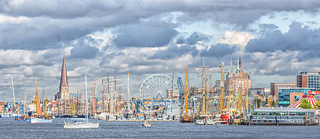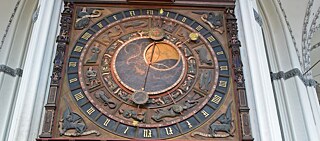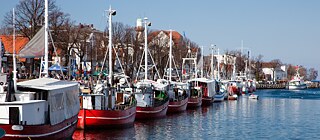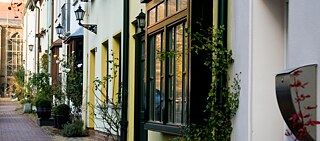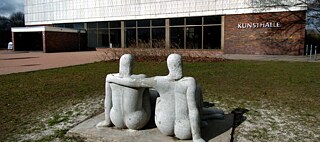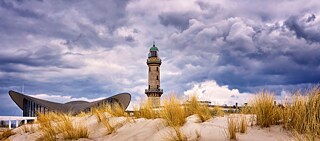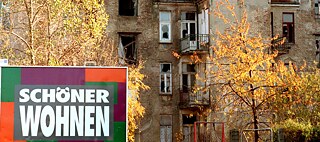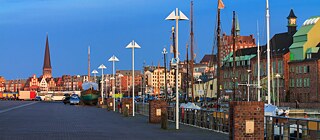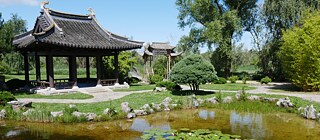Tourists nationwide know the Rostock district of Warnemünde for its beach, lighthouse, pier, and fish butties. The city of Rostock itself is generally associated with shipyards, the fishing combines used in the GDR, and the Lichtenhagen pre-fab housing estate. So it is high time we took a closer look at this historic Hanseatic league city.
By Frank Schlößer
Astronomical clock in St. Marien
Astronomical clock in the St. Marienkirche.
| Photo (detail): © Adobe
It is not easy to see the astronomical clock – which shows not only the time, but also the signs of the zodiac, the date, the position of the sun and the phases of the moon – in all its full glory. There just is not quite enough room in the choir loft behind the altar in St. Marien (St. Mary’s) church. Even if you tilt your head back, you can just catch a glimpse of the glorious “Apostles’ Walk” on the giant clock enthroned 11 meters up. Then, at noon every day, Jesus blesses all the apostles, except for Judas, who gets the door to heaven slammed in his face during the last bars of the chimes. Gdansk master clockmaker Hans Düringer gifted the clock to the city in 1472. Since then, it has undergone a few restorations, been sometimes more, sometimes less functional, and twice stopped entirely for a few years. But today, it is still keeping time with the original parts and wound by hand every day. The white date disc is the only part meant to suffer “wear and tear”: It has to be replaced every 133 years to sync up with our calendar again. The most recent replacement went in at the beginning of January 2018 to kick off the “800 years of Rostock” celebrations.
Universitätsplatz
University square.
| Photo (detail): © Adobe
In summer, Universitätsplatz (University Square) is the beating heart of Rostock’s downtown: The “Brunne der Lebensfreude” (Joie de Vivre Fountain) energetically sprays jets of water around while sculptures of swans, wild boars and people enjoy each other’s company. Kids find the pool irresistible in the warm summer months, so experienced Rostock parents always carry a dry change of clothes. The 1980s artistic redesign was an urban strategy for overcoming the trauma of the April 1942 bombings that destroyed the northern flank of the triangular square with its bourgeois, Hanseatic gabled buildings. The GDR’s housing authority erected the Fünfgiebelhaus, (Five-Gabled House), a prefabricated structure that does not show its prefab nature. The building with five pretty, small-scale facades and five individually designed gables houses stores and flats, which in combination with the new fountain, restored the square’s historic downtown atmosphere. Many of Rostock’s attractions surround the Uni-Platz. These include a monument to Rostock native Marshal Gerhard Leberecht von Blücher, who in 1815 led the Prussian cavalry to help turn the Battle of Waterloo into Napoleon’s defeat, the magnificent main university building, the Cultural Museum Rostock, the bells of the Glockenspiel, the Capitol cinema, the famous zoological collection with the “Pfeilstork” (Arrow Stork), the Studentenkeller beer garden, and stands for ice cream, coffee and bratwurst.
Alter Strom
Tour ships weigh anchor here, and there is much more to explore around the old canal.
| Photo (detail): © Adobe
If you start at Warnemünde train station and want to get to the Baltic Sea – perhaps to see the lighthouse or the Teepott, a restaurant named for the shape of its roof (which, by the way, does not resemble a teapot at all, but is shaped like a hypar shell, i.e. a double-curved surface) – after the obligatory selfie on the swing bridge over the “Alter Strom” (Old Stream) canal, you will inevitably have to turn right. New stores and boutiques join the traditional restaurants here every year. Tour boats to Rostock and a round trip to the overseas port cast off from here, as do the cutters for all those who want to try their hand at deep-sea fishing. This is the place to enjoy fresh and smoked fish, amber, a brisk breeze from the Baltic Sea, and the international buzz of voices of the day trippers against the backdrop of huge cruise ships. The Alte Strom got its name when the new canal, the Neue Strom, opened next door for the ever-larger ships in 1903. The traditional “old” River Warnow estuary became a maritime cul-de-sac and has found a new purpose as a fun spot for bathers. It is easy to understand why the large sunshades are stretched out in front of the cutters selling fish butties no matter the weather, as the experienced seagulls can snatch the Bismarck herring right out of the rolls of careless tourists in a precisely timed fly-by. You don’t, by the way, have to turn right after the swing bridge. If you manage to swim against the tide and take a left instead, you will be rewarded with a quiet walk along the picturesque, original end of the Alter Strom.
Petrikirche and the historical city centre
Picturesque alleyways in the historic city centre.
| Photo (detail): © Adobe
Since 1994, the 117-meter-high tower of the Petrikirche (St. Peter’s Church) has again been one of Rostock’s landmarks. A fundraising campaign made it possible to restore the striking, slender spire to its rightful place more than 50 years after a destructive bombing raid. In the 12th century, the first of the three towns that now make up Rostock and which shared a city wall from 1265 was founded on this hill above the River Warnow. Throughout the pretty, historic town centre, the street names memorialise the people who once toiled and cursed in the local Low German dialect here, the craftsmen and fishermen who made the place their home: Fischerbruch, Braugasse, Altschmiedestraße (Fisherman’s Break, Brewer’s Alley, Old Blacksmith Street). By 2001, the old Katharinenkloster (St. Catherine’s Monastery) was converted into an architectural gem and is now home to the Hochschule für Musik und Theater (University of Music and Theatre). Every department contributes to the calendar of cultural events in the Hanseatic city. You cannot park or shop in the historic old town, but you can take commerce-free walks through picturesque alleys and enjoy magnificent views: either over the city wall, over the Warnow lowlands, or down on the city from the viewing platform in the tower of the Petrikirche.
Kunsthalle Rostock
Long considered just some “Ossi thing”, the museum is again good for a surprise.
| Photo (detail): © picture-alliance/dpa/dpaweb/Bernd Wüstneck
In the GDR, city planners did not have to consider the flow of tourists. So in 1969, they built their first new museum outside the city centre, turning the park on a swan pond in the Reutershagen district into a destination for art lovers. The short trip by streetcar to the Rostock Art Gallery is well worth it: The plain white cube, complete with café and “grasses garden”, has large rooms on two floors that were created for the sole purpose of showing off the pieces on display. During the remaining twenty years of the GDR, the exhibitions of contemporary art were intended as a way for the GDR to present itself as a cosmopolitan country in the port city of Rostock. This image meant the museum was regarded as “just an Ossi (East German) thing” in the first two decades after reunification and was threatened with closure from time to time. Until 2009, when Rostock dentist Jörg-Uwe Neumann and an association took the place over. Since then, word has spread throughout Germany that the museum is once again good for a surprise: A.R. Penck and Joop, Norbert Bisky and Andreas Mühe, Günther Uecker and Georg Baselitz, and Christo & Jeanne Claude have all exhibited here. Contrary viewpoints from young, contemporary artists from all over the world are as much part of the programme as centuries-old classics by Ernst Barlach and Camille Claudel. Nevertheless, the museum has remained an “Ossi thing”. Today, exhibitions on the “Platz der Republik” (Palace of the Republic), the legendary GDR fashion magazine “Sibylle,” and the GDR film productions that were called “Indian films” are presented with a new sense of self-confidence.
Warnemünde middle pier
On of the lighthouses in Warnemünde. At its feet: the Teepott.
| Photo (detail): © Adobe
Horizon, wind and water: The huge Scandinavian ferries and the sailing ships that have their moorings in the city port pass by on the right. On the left, cutters and excursion ships chug into the Alter Strom. Straight ahead, two pier lighthouses, one red, one green. And all around: nothing. A railing, a few steps. Even if Warnemünde is bursting at the seams with tourists in summer – the middle pier, the spit of land between the old and new canals, is the eye of the hurricane. Here no one will try to force ice cream, beer or a fish butty on you. If this sounds pretty nice, just take the train to Warnemünde and walk in the same direction as the train – either on the quay to see the cruise ships or across the middle pier’s large parking lot, probably the most beautiful parking lot in Germany. From 1903 to 1995, railroad trains rolled directly into the belly of the ferry and across to Gedser, Denmark. Even the “Trajekt Warnemünde – Gedser” railroad ramp is still visible. The basin the train ferries with their foldable rumps backed into was filled in in 2014 to create additional land in an exclusive location where new residential and commercial areas were planned. But the long-established residents of Warnemünde, who do not particularly care to be railroaded by the Rostock city administration, have successfully blocked this development for the time being. The city’s housing association owns the area and has so far seemed content with the income from the parking lot. Rostock’s new mayor, Claus Ruhe Madsen, has announced a “new start for the middle pier”. But the most beautiful parking lot in Germany probably has a few more summers left.
The KTV
A picture from back in the day when squatters occupied the run-down streets of houses in the Kröpeliner Gate Suburb. Today the newly renovated area is a hip place to be.
| Photo (detail): © picture-alliance/ ZB/Bernd Wüstneck
Around the turn of the century before last, Rostock began to expand beyond its historic city walls. A suburb grew outside the city gate towards the town of Kröpelin – and was given the name: “Kröpeliner-Tor-Vorstadt” (Kröpelin Gate Suburb), or “KTV” for short. Colourful stores, late-night corner shops, al fresco dining – this part of town is young, vital, and getting more and more expensive. Around one tenth of Rostock’s 200,000 residents live here. And even with the daily annoyance of graffiti, dog poop and practically non-existent parking spaces, they would not want to live anywhere else. During the GDR era, the KTV was considered a pretty rough part of town. While the large, prefabricated housing districts were being built towards Warnemünde, entire streets fell into disrepair here. Squatters moved in, living with a shared toilet halfway up the stairs and a weekly trip to the public baths. In the mid-1990s, the European Union launched an exorbitant subsidy program – and a few years later, the facades were beautiful again, the roofs watertight, and many an investor had gotten their cut during the renovations. The “Lichtspieltheater Wundervoll” programme cinema, or “LiWu” for short, operates two theatres here. Doberaner Platz is the square with the highest density of bakeries in Germany, and if there is anywhere in Mecklenburg-Vorpommern where you can choose between Arabian, Russian, Vietnamese, Italian, Greek, Indian, Japanese or German food inside a 150-metre radius, it is here.
The city port
The long quayside of Rostock’s city port.
| Photo (detail): © Adobe
The quayside in the city is long and serves as a jogging route, jetty and party mile rolled into one. The city port was already a meeting place for young people before the outbreak of the Corona pandemic, but the number of walkers has increased with each lockdown. It was a pleasant place to be, by the water, in the fresh air, with a view across to the green banks of the River Warnow . Of course, restaurateurs have also long since discovered the potential of the city port. Between the large “Golden Bay” Asian restaurant on the wooden peninsula and the high-end “Otto’s” restaurant ship, there are not only three kilometres, but also several other restaurants and open-air lounges for chilling. Until the sixties, this area had all the usual hustle and bustle of a port. This later shifted to the new overseas port outside the city, but the smaller ships of the GDR merchant fleet and the supply ships of the Soviet Army units stationed in the GDR were still unloaded at the city port. The port was a restricted area. Two unloading cranes and a large bridge crane still stand as reminders of the flair of that time: Many yachts and cutters, any number of sailing ships and the icebreaker “Stephan Jantzen” are moored here, and a large area serves as a municipal parking lot. Otherwise, the city seems at a bit of a loss about what to do with it – besides plans drawn up for the Federal Garden Show scheduled for 2025. Until then, there will always be enough places here to set up a grill. Even if, in the end, there are only a few summer nights when it is warm enough to hang out all night in the city port – they are sure to be remembered.
IGA Park
Chinese garden in IGA Park.
| Photo (detail): © Adobe
More than half of Rostock’s residents live in prefabricated housing estates, which were built in the GDR era to provide housing for workers in the industrial sector. Living there is not as bad as one might imagine from the outside. The city also decided to upgrade the overgrown Warnow embankment in the Schmarl quarter. The right opportunity arose when Rostock was awarded the contract for the 2003 World Horticultural Exhibition. Although the summer left a serious hole in the coffers, since then the city has had the world’s largest living structure in the form of the Weidendom (Willow Dome), a great meadow for open-air concerts, a beautiful park and a berth for the world’s largest floating museum. The maritime museum is aboard the “Tradi,” as the traditional “Frieden” type ship is still called, although the old ship’s name “Dresden” has long since been restored to the bow. From 2003, organisers have tried everything conceivable to encourage the people of Rostock to get to know the somewhat remote park. But it is only recently that the IGA Park has really been on the shortlist when families discuss where they might spend the next sunny day. The “Tradi” has overcome its boring museum image, the open-air stage has been professionalized with a top-notch backstage area, the rustic quayside has some surprising street food ideas on offer, and on the Warnow, the new water-skiing facility offers hours of entertainment: with impressed “ahhs” and “ohhs” for the more advanced and heartfelt schadenfreude for the beginners.
Swimming in the river
An outdoor pool for the whole family from toddlers to grandmothers: the Flussbad Rostock.
| Photo (detail): © Flussbad Rostock
The Lower Warnow between Rostock and Warnemünde smells of the Baltic Sea and the big wide world, while the Upper Warnow is the quiet river that flows the 150 kilometres from the southwest to reach the Hanseatic city. First, the waterworks siphon off the city’s drinking water, then the Warnow flows a short distance further to Mühlendamm (Mill Dam). It has not powered any mills in quite a while, and the once essential lock has now been filled in, neatly separating the brackish water from the fresh water. This idyll is only a 15-minute walk or two bus stops from the city centre and has weathered the ups and downs of the Hanseatic city as a “river and sun bathing area” for 100 years. As an outdoor pool for the whole family from toddlers to grandmothers, as a summer destination for generations of city schoolchildren, including novelty ice creams, chips with mayonnaise and courageous jumps from the five-meter tower. In 2003, the city wanted to sell it, but a municipal association stepped in and presented a coherent concept for repair and continued operation. Since then, something new has been added every year – from the slide above the new footbridge border strip to the fresh gravel in the non-swimmer’s pool. Next to the river swimming facility, by the way, you can quickly rent a canoe or kayak for a relaxing afternoon on the water.
